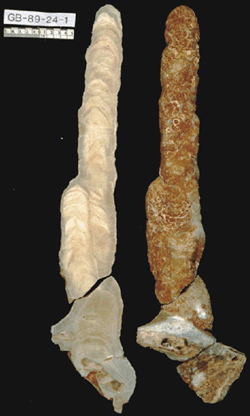Carbon dating is a mainstay of geology and archaeology - but an enormous peak discovered in the amount of carbon-14 in the atmosphere between 45 thousand and 11 thousand years ago casts doubt on the biological carbon cycle that underpins the technique. The study led by physicist Warren Beck of the University of Arizona, US, could also affect estimates of how quickly the Earth can re-absorb the excess carbon dioxide generated by fossil fuels (J W Beck et al 2001 Science to appear).

Living organisms and some geological features absorb stable carbon-12 and radioactive carbon-14, which are present in the air in a well-known ratio. This is part of the carbon cycle – the recirculation of carbon through the oceans, atmosphere, plants and animals. Scientists use carbon dating to determine when objects ceased to absorb carbon by measuring how much of the carbon-14 – which has a half-life of 5730 years – has decayed. But Beck and colleagues believe that the ratio of stable and radioactive carbon in the atmosphere may have changed considerably over the last 50 thousand years. This raises questions about the accuracy of carbon dating for very old objects.
Beck and colleagues tested slices of a half-metre long stalagmite that grew between 45 000 and 11 000 years ago in a cave in the Bahamas. Stalagmites are calcium carbonate deposits left behind when carbon dioxide evaporates out of cave seepage water. They found that carbon-14 concentrations were twice their modern level during that period. Current records of the levels of carbon-14 in the atmosphere only cover the last 16 thousand years, and this discovery extends those records a further 30 thousand years.
Galactic cosmic rays create most of the carbon-14 in our atmosphere, while solar cosmic rays generate a smaller fraction. The Earth is partially shielded from galactic cosmic rays by its own magnetic field and the solar magnetic field, which fluctuates as the solar cycle proceeds. But these effects are predictable and are thought to have changed little in the last million years – which means they cannot explain the glut of carbon-14. Evidence from North Atlantic sediments suggests that the Earth’s magnetic field may have dipped around 40 thousand years ago, but this would still only account for – at best – half of the observed peak in carbon-14 concentrations.
Beck’s team concludes that either a jump in the cosmic ray flux or a fundamental change in the carbon cycle must have produced the sudden increase of carbon-14. The team speculates that a supernova shock wave could have produced a flurry of cosmic rays. “Weaker circulation of the oceans – which are the biggest reservoirs of carbon on Earth – would explain the excess of carbon-14”, David Richards, joint team leader, told PhysicsWeb. If carbon-14 is carried more slowly from the surface to the depths of the ocean, he explains, the carbon-14 content of the atmosphere will rise.
The discovery also has implications for our understanding of the environment as a whole. “We should take this as a warning that climate change may affect the carbon cycle in previously unexpected way”, says Beck.



